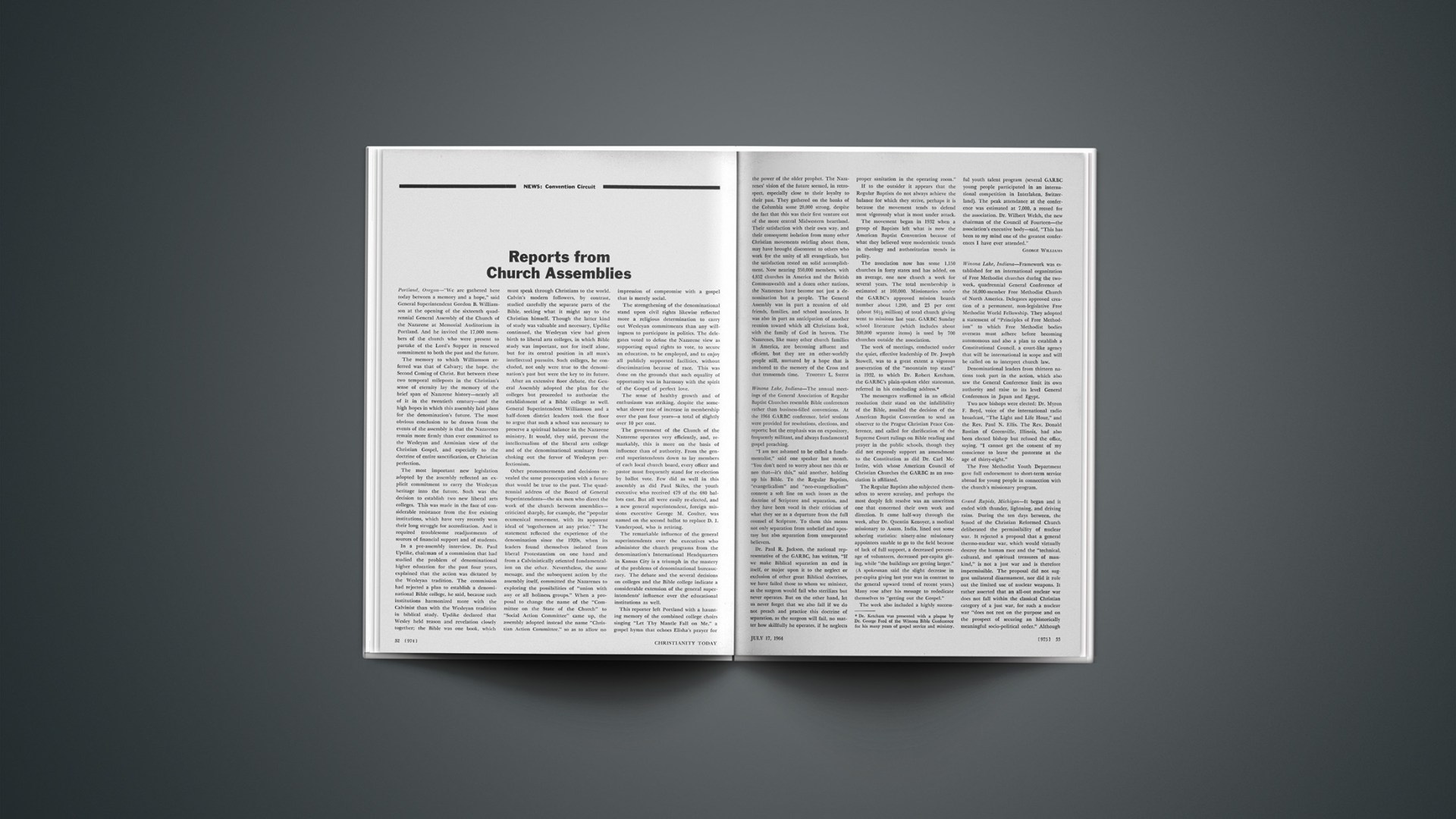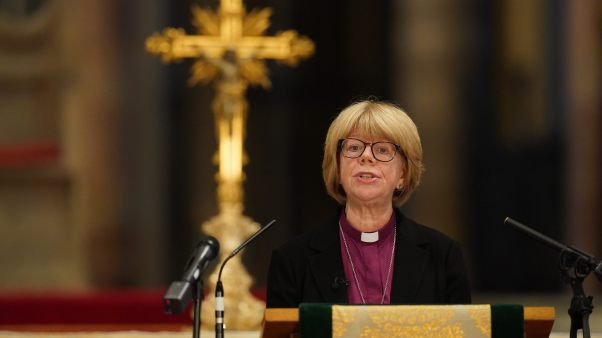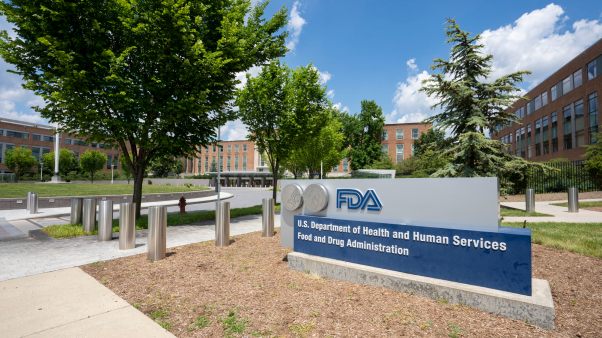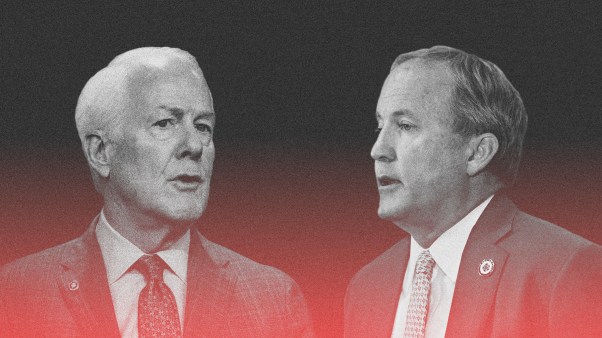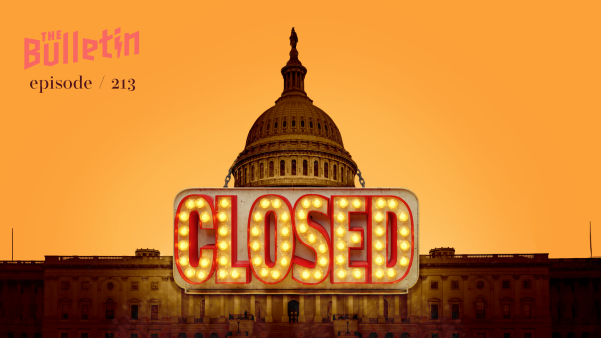Portland, Oregon—“We are gathered here today between a memory and a hope,” said General Superintendent Gordon B. Williamson at the opening of the sixteenth quadrennial General Assembly of the Church of the Nazarene at Memorial Auditorium in Portland. And he invited the 17,000 members of the church who were present to partake of the Lord’s Supper in renewed commitment to both the past and the future.
The memory to which Williamson referred was that of Calvary; the hope, the Second Coming of Christ. But between these two temporal mileposts in the Christian’s sense of eternity lay the memory of the brief span of Nazarene history—nearly all of it in the twentieth century—and the high hopes in which this assembly laid plans for the denomination’s future. The most obvious conclusion to be drawn from the events of the assembly is that the Nazarenes remain more firmly than ever committed to the Wesleyan and Arminian view of the Christian Gospel, and especially to the doctrine of entire sanctification, or Christian perfection.
The most important new legislation adopted by the assembly reflected an explicit commitment to carry the Wesleyan heritage into the future. Such was the decision to establish two new liberal arts colleges. This was made in the face of considerable resistance from the five existing institutions, which have very recently won their long struggle for accreditation. And it required troublesome readjustments of sources of financial support and of students.
In a pre-assembly interview, Dr. Paul Updike, chairman of a commission that had studied the problem of denominational higher education for the past four years, explained that the action was dictated by the Wesleyan tradition. The commission had rejected a plan to establish a denominational Bible college, he said, because such institutions harmonized more with the Calvinist than with the Wesleyan tradition in biblical study. Updike declared that Wesley held reason and revelation closely together; the Bible was one book, which must speak through Christians to the world. Calvin’s modern followers, by contrast, studied carefully the separate parts of the Bible, seeking what it might say to the Christian himself. Though the latter kind of study was valuable and necessary, Updike continued, the Wesleyan view had given birth to liberal arts colleges, in which Bible study was important, not for itself alone, but for its central position in all man’s intellectual pursuits. Such colleges, he concluded, not only were true to the denomination’s past but were the key to its future.
After an extensive floor debate, the General Assembly adopted the plan for the colleges but proceeded to authorize the establishment of a Bible college as well. General Superintendent Williamson and a half-dozen district leaders took the floor to argue that such a school was necessary to preserve a spiritual balance in the Nazarene ministry. It would, they said, prevent the intellectualism of the liberal arts college and of the denominational seminary from choking out the fervor of Wesleyan perfectionism.
Other pronouncements and decisions revealed the same preoccupation with a future that would be true to the past. The quadrennial address of the Board of General Superintendents—the six men who direct the work of the church between assemblies—criticized sharply, for example, the “popular ecumenical movement, with its apparent ideal of ‘togetherness at any price.’ ” The statement reflected the experience of the denomination since the 1920s, when its leaders found themselves isolated from liberal Protestantism on one hand and from a Calvinistically oriented fundamentalism on the other. Nevertheless, the same message, and the subsequent action by the assembly itself, committed the Nazarenes to exploring the possibilities of “union with any or all holiness groups.” When a proposal to change the name of the “Committee on the State of the Church” to “Social Action Committee” came up, the assembly adopted instead the name “Christian Action Committee,” so as to allow no impression of compromise with a gospel that is merely social.
The strengthening of the denominational stand upon civil rights likewise reflected more a religious determination to carry out Wesleyan commitments than any willingness to participate in politics. The delegates voted to define the Nazarene view as supporting equal rights to vote, to secure an education, to be employed, and to enjoy all publicly supported facilities, without discrimination because of race. This was done on the grounds that such equality of opportunity was in harmony with the spirit of the Gospel of perfect love.
The sense of healthy growth and of enthusiasm was striking, despite the somewhat slower rate of increase in membership over the past four years—a total of slightly over 10 per cent.
The government of the Church of the Nazarene operates very efficiently, and, remarkably, this is more on the basis of influence than of authority. From the general superintendents down to lay members of each local church board, every officer and pastor must frequently stand for re-election by ballot vote. Few did as well in this assembly as did Paul Skiles, the youth executive who received 479 of the 480 ballots cast. But all were easily re-elected, and a new general superintendent, foreign missions executive George M. Coulter, was named on the second ballot to replace D. I. Vanderpool, who is retiring.
The remarkable influence of the general superintendents over the executives who administer the church programs from the denomination’s International Headquarters in Kansas City is a triumph in the mastery of the problems of denominational bureaucracy. The debate and the several decisions on colleges and the Bible college indicate a considerable extension of the general superintendents’ influence over the educational institutions as well.
This reporter left Portland with a haunting memory of the combined college choirs singing “Let Thy Mantle Fall on Me,” a gospel hymn that echoes Elisha’s prayer for the power of the older prophet. The Nazarenes’ vision of the future seemed, in retrospect, especially close to their loyalty to their past. They gathered on the banks of the Columbia some 20,000 strong, despite the fact that this was their first venture out of the more central Midwestern heartland. Their satisfaction with their own way, and their consequent isolation from many other Christian movements swirling about them, may have brought discontent to others who work for the unity of all evangelicals, but the satisfaction rested on solid accomplishment. Now nearing 350,000 members, with 4,852 churches in America and the British Commonwealth and a dozen other nations, the Nazarenes have become not just a denomination but a people. The General Assembly was in part a reunion of old friends, families, and school associates. It was also in part an anticipation of another reunion toward which all Christians look, with the family of God in heaven. The Nazarenes, like many other church families in America, are becoming affluent and efficient, but they are an other-worldly people still, nurtured by a hope that is anchored to the memory of the Cross and that transcends time.
Winona Lake, Indiana—The annual meetings of the General Association of Regular Baptist Churches resemble Bible conferences rather than business-filled conventions. At the 1964 GARBC conference, brief sessions were provided for resolutions, elections, and reports; but the emphasis was on expository, frequently militant, and always fundamental gospel preaching.
“I am not ashamed to be called a fundamentalist,” said one speaker last month. “You don’t need to worry about neo this or neo that—it’s this,” said another, holding up his Bible. To the Regular Baptists, “evangelicalism” and “neo-evangelicalism” connote a soft line on such issues as the doctrine of Scripture and separation, and they have been vocal in their criticism of what they see as a departure from the full counsel of Scripture. To them this means not only separation from unbelief and apostasy but also separation from unseparated believers.
Dr. Paul R. Jackson, the national representative of the GARBC, has written, “If we make Biblical separation an end in itself, or major upon it to the neglect or exclusion of other great Biblical doctrines, we have failed those to whom we minister, as the surgeon would fail who sterilizes but never operates. But on the other hand, let us never forget that we also fail if we do not preach and practice this doctrine of separation, as the surgeon will fail, no matter how skillfully he operates, if he neglects proper sanitation in the operating room.”
If to the outsider it appears that the Regular Baptists do not always achieve the balance for which they strive, perhaps it is because the movement tends to defend most vigorously what is most under attack.
The movement began in 1932 when a group of Baptists left what is now the American Baptist Convention because of what they believed were modernistic trends in theology and authoritarian trends in polity.
The association now has some 1,150 churches in forty states and has added, on an average, one new church a week for several years. The total membership is estimated at 160,000. Missionaries under the GARBC’s approved mission boards number about 1,200, and 23 per cent (about $4½ million) of total church giving went to missions last year. GARBC Sunday school literature (which includes about 300,000 separate items) is used by 700 churches outside the association.
The week of meetings, conducted under the quiet, effective leadership of Dr. Joseph Stowell, was to a great extent a vigorous asseveration of the “mountain top stand” in 1932, to which Dr. Robert Ketcham, the GARBC’s plain-spoken elder statesman, referred in his concluding address.1Dr. Ketcham was presented with a plaque by Dr. George Ford of the Winona Bible Conference for his many years of gospel service and ministry.
The messengers reaffirmed in an official resolution their stand on the infallibility of the Bible, assailed the decision of the American Baptist Convention to send an observer to the Prague Christian Peace Conference, and called for clarification of the Supreme Court rulings on Bible reading and prayer in the public schools, though they did not expressly support an amendment to the Constitution as did Dr. Carl McIntire, with whose American Council of Christian Churches the GARBC as an association is affiliated.
The Regular Baptists also subjected themselves to severe scrutiny, and perhaps the most deeply felt resolve was an unwritten one that concerned their own work and direction. It came half-way through the week, after Dr. Quentin Kenoyer, a medical missionary to Assam, India, lined out some sobering statistics: ninety-nine missionary appointees unable to go to the field because of lack of full support, a decreased percentage of volunteers, decreased per-capita giving, while “the buildings are getting larger.” (A spokesman said the slight decrease in per-capita giving last year was in contrast to the general upward trend of recent years.) Many rose after his message to rededicate themselves to “getting out the Gospel.”
The week also included a highly successful youth talent program (several GARBC young people participated in an international competition in Interlaken, Switzerland). The peak attendance at the conference was estimated at 7,000, a record for the association. Dr. Wilbert Welch, the new chairman of the Council of Fourteen—the association’s executive body—said, “This has been to my mind one of the greatest conferences I have ever attended.”
Winona Lake, Indiana—Framework was established for an international organization of Free Methodist churches during the two-week, quadrennial General Conference of the 56,000-member Free Methodist Church of North America. Delegates approved creation of a permanent, non-legislative Free Methodist World Fellowship. They adopted a statement of “Principles of Free Methodism” to which Free Methodist bodies overseas must adhere before becoming autonomous and also a plan to establish a Constitutional Council, a court-like agency that will be international in scope and will be called on to interpret church law.
Denominational leaders from thirteen nations took part in the action, which also saw the General Conference limit its own authority and raise to its level General Conferences in Japan and Egypt.
Two new bishops were elected: Dr. Myron F. Boyd, voice of the international radio broadcast, “The Light and Life Hour,” and the Rev. Paul N. Ellis. The Rev. Donald Bastian of Greenville, Illinois, had also been elected bishop but refused the office, saying, “I cannot get the consent of my conscience to leave the pastorate at the age of thirty-eight.”
The Free Methodist Youth Department gave full endorsement to short-term service abroad for young people in connection with the church’s missionary program.
Grand Rapids, Michigan—It began and it ended with thunder, lightning, and driving rains. During the ten days between, the Synod of the Christian Reformed Church deliberated the permissibility of nuclear war. It rejected a proposal that a general thermo-nuclear war, which would virtually destroy the human race and the “technical, cultural, and spiritual treasures of mankind,” is not a just war and is therefore impermissible. The proposal did not suggest unilateral disarmament, nor did it rule out the limited use of nuclear weapons. It rather asserted that an all-out nuclear war does not fall within the classical Christian category of a just war, for such a nuclear war “does not rest on the purpose and on the prospect of securing an historically meaningful socio-political order.” Although the 128 delegates refused to adopt the proposal as a guideline for the thinking of the church’s membership, they did recommend the plan to the membership for study.
A recommendation was made by a standing committee that an overture from Classis Central California requesting official action for closer fellowship with the Reformed Church in America be rejected; the recommendation was unanimously tabled. Instead the delegates of the 108-year-old denomination referred the request to the Committee on Inter-Church Correspondence. The Christian Reformed Church withdrew from the RCA in 1857. The two churches have a common credo and heritage.
A statement on race that had been adopted by the Reformed Ecumenical Synod, of which the Dutch Reformed Church in South Africa is a member, was adopted last month by the CRC delegates. The statement asserts, “God’s Word does not teach either racial integration or separate racial development as a universally regulative principle expressing God’s will for our Christian conduct in race relations.”
Pan-Presbyterianism
When do “talks” between churches become “conversations,” and when do “conversations” become “negotiations” for union?
Presbyterians throughout the nation are beginning to wonder. Almost all of them are involved, in one way or another, in “talks,” “conversations,” or “negotiations.”
Whether the result of all the discussion will be a new denomination devoted to the Reformed faith and Presbyterian order is the question on the mind of evangelicals. In the background of all discussion on the matter is the fact that the United Presbyterian Church in the U. S. A. is a leading participant in the “Blake-Pike” Consultation on Church Union, which includes such communions as the Methodists, Episcopalians, and Disciples.
The Presbyterian U. S. (Southern) General Assembly in 1963 decided that “ultimately the Presbyterian and Reformed Communions in the United States should present a united life and witness according to the Reformed faith and Presbyterian order.” The action was reaffirmed by the denomination’s 1964 General Assembly in April.
In May the United Presbyterian General Assembly approved a letter to its Southern cousins, inviting them to conversations to explore “the conditions conducive to union and that make union imperative now.”
In addition, the UPUSA assembly authorized appointment of a twelve-man committee to join negotiations already going on between Southern Presbyterians and the Reformed Church in America. The April Southern assembly had suggested that its talks with the RCA might be broadened to include the UPUSA, but only with RCA concurrence.
The RCA met in June and ruled out the possibility that the negotiations would be broadened. A 1962 decision “to hold other union possibilities in abeyance” was reaffirmed. That left the UPUSA, largest of American Presbyterian denominations, out of the Presbyterian-Reformed negotiations.
Meanwhile, UPUSA officials were dispatching to the other Presbyterian bodies copies of the invitation they sent to Southern Presbyterians to hold exploratory conversations.
First to respond was the 27,000-member union-shy Associate Reformed Presbyterian Church. Its General Synod, meeting at the same time the corresponding body of the RCA was in session, accepted the UPUSA invitation.
The UPUSA letter was not presented to the RCA synod.
The letter was before the Cumberland Presbyterian Assembly, but no formal answer was voted. Instead, the Cumberland judicatory enlarged the scope of its interchurch relations committee’s work and authorized it to handle such correspondence.
ARTHUR H. MATTHEWS
A study committee was appointed to investigate the missionary message of the church’s professor of missions at Calvin Seminary and to determine whether his views are in harmony with biblical teaching and the church’s confessions regarding limited atonement. The professor, Harold Dekker, has pleaded the permissibility of preaching to any man “God loves you,” and “Christ died for you.”
Next year the Synod will meet in Sioux Center, Iowa, home of church-free Dordt College. This will be the first time in decades it has convened outside Grand Rapids, Michigan.
Long Beach, California—Conservative Baptists, long haunted by a hard-core ultra-right element, met June 18–23 for their twenty-first annual fellowship in sessions that were relatively mild, although moderates scored significant advances on several fronts.
One highlight of the sessions was the resolution of a vexing problem involving leadership of the Conservative Baptist Foreign Mission Society. Dr. Vincent Brushwyler, general director of the society since its beginning, had been under gross pressures during the past several years. He submitted his resignation last January, and after some tactical maneuvers the resignation was accepted by the society’s board. The matter threatened to erupt in the sessions at Long Beach. Indeed, there was considerable discussion of it in several open forums. The delegates regretted Dr. Brushwyler’s resignation but also expressed confidence in the board. A largely attended banquet on Friday evening honored Dr. Brushwyler for his long and effective years of service, during which some 500 missionaries were sent out by the board. He was given prolonged applause.
The hard-core element of the fellowship received its most substantial defeat in the transactions of the Conservative Baptist Home Mission Society. At the Central Regional meeting of the society’s board last fall, the dissident group sought to control matters by refusing to permit the vice-president, Dr. Russell Pavy, to preside over the meeting in the absence of the president. Since the constitution requires that the vice-president preside in the president’s absence, the board declared the meeting illegal and vacated the offices that had been filled. The matter came up for discussion and decision at Long Beach. Dr. Pavy took the floor to answer charges against him, and at the conclusion of his defense the delegates gave him a tremendous ovation. The victory for the moderates was further strengthened by the election of Pavy as president of the Home Mission Society.
Another victory for moderation was the election of Donald Bjork as treasurer of the Conservative Baptist Association of America. He was nominated from the floor after the hard-core element had presented the name of Floyd Northrop to the delegates. Bjork’s sound defeat of Northrop made it evident that the moderates were in control.
A banquet given by the Conservative Baptist Seminary of Denver was attended by 600 messengers. In a masterful address President Vernon Grounds inveighed against divisive members of the fellowship who use typewriter and mimeograph to assassinate character and poison the minds of the constituency. He came out strongly for the authority and inerrancy of the Holy Scriptures, while at the same time he distinguished between human interpretation and biblical authority. He forecast that certain elements of the fellowship would lead it into divisive sectarianism if they were permitted to destroy soul competency, the priesthood of believers, and the right to private interpretation of the Scriptures. Calling for the end of disunity and disruption, President Grounds stated that Baptists have a Man—Christ Jesus; a cause—the Gospel of Christ; and a strategic opportunity in one of history’s darkest hours.
The various agencies of the fellowship reported increased incomes and a forward movement generally. The delegates elected Dr. Herbert Anderson, minister of the Hinson Memorial Baptist Church of Portland, Oregon, as president of the association. Dr. Lloyd T. Anderson, minister of the Bethany Baptist Church of Covina, California, was elected president of the Foreign Mission Society.
Resolutions passed by the messengers included statements against the ecumenical movement, against immodesty in dress as evidenced by the new-style bathing suits, against Communism, and against the teaching of evolution in public schools. The messengers reaffirmed their belief in individual rights, deplored anti-Semitism, and called for freedom of worship and the use of the Bible in public life and institutions.
Toronto—A new Book of Common Order was approved by delegates to the ninetieth General Assembly of the Presbyterian Church in Canada.
The book, characterized by opponents as incorporating “Catholicizing tendencies,” represents eleven years of committee work. It is the first major revision of the book since 1938 and is intended for voluntary use in the Presbyterian churches of Canada.
The final vote on the revised book was by show of hands. There were only five dissents, but many of the 250 delegates abstained.
Critics say that the new book introduces the rite of christening, that its baptismal service prayers teach baptismal regeneration, and that the preamble to the ordination service is not in accord with the Westminster Confession.
Assembly delegates, meeting at Knox College, authorized discussions with the United Church of Canada on cooperation and the biblical meaning of unity. They also approved discussions between a subcommittee from the Committee on Articles of Faith and a United Church of Canada group.
The delegates set aside, however, a move to have a subcommittee on church music consult with a similar group from the United Church to produce a hymn book.
The assembly urged the federal government to revise the Canadian Criminal Code to allow married couples to buy birth control devices legally.
A proposal that Canadian law be liberalized by recognizing willful desertion as legal grounds for divorce was endorsed.
The denomination’s eight synods were asked to make studies with a view to “rooting out racial and ethnic discrimination in the church and by Presbyterians in all their work and relationships.”
Hamilton, Ontario—Delegates to the seventy-fifth anniversary assembly of the Baptist Convention of Ontario and Quebec voted to accept a new Sunday school curriculum prepared jointly with the United Church of Canada despite protests that the material embraces critical views of the Scripture. According to Religious News Service, the Rev. Leland Gregory, general secretary of the convention, told the assembly that if Baptists withdrew from the joint project, they would be morally bound to pay $50,000. Denominational administrators were instructed to assist any congregation that sought to secure other material from U. S. Baptist sources.
The delegates represented some 50,000 Baptists in 450 congregations. They form the middle geographical third of the Baptist Federation of Canada.
Minneapolis—A referendum among congregations of the Evangelical Covenant Church of America to determine whether they want their denomination to affiliate with interchurch organizations was authorized by a vote of delegates at the denomination’s annual meeting.
The Evangelical Covenant Church, which embraces some 80,000 members, does not now belong to any group such as the National Council of Churches or the National Association of Evangelicals.
Delegates voted to deplore “irresponsible and violent methods of expressing racial sympathies,” but they affirmed “the rightness of orderly and non-violent means of combating injustice toward racial minorities.” They recorded their “profound appreciation” over Senate passage of the civil rights bill.
Ocean Grove, New Jersey—Trinity College, operated by the Evangelical Free Church of America, will be moved from the northwest side of Chicago to suburban Bannockburn, Illinois, according to legislation enacted at the church’s eightieth annual general conference. The Evangelical Divinity School, also operated by the church, is already located on the 79-acre Bannockburn plot.
A 3 per cent membership growth was reported for the past year, and per-capita giving rose to $233.43, up $50 from five years ago. The denomination now has some 41,700 members.
One of the denomination’s ministers, the Rev. Theodore DeBoer, of Lake Alfred, Florida, was killed in a traffic accident en route to the conference.
Chicago—At its annual session, held for the first time, as a resolution phrased it, “in the far North,” the American Baptist Association adopted an omnibus resolution noting that “this nation’s society has reached a new high in low living, due in large measure to a type of advertising in many fields that encourages man to ignore restraints and let his carnal nature have its way.” The resolution asserted that “in spite of the constant diet fads, improper diet and over indulgence in foods is responsible for great health loss to our nation.” It also pointed to a raising rate of alcoholism, to the effect of cigarettes on the death toll, and to slaughter on the highways.
The ABA is a group of more than 3,000 churches with an aggregate membership of 653,000. Most are located in the South.
Cape May, New Jersey—A representative of the Southern Christian Leadership Conference appealed to the Friends General Conference for continued support in behalf of civil rights. The Rev. Wyatt Tee Walker told the 3,000 Quaker delegates that the demonstrations will increase and that the emphasis of future demonstrations will be on enforcement and implementation of the civil rights bill.
Fergus Falls, Minnesota—The Church of the Lutheran Brethren in America, at its sixty-fourth annual convention, ratified a change in its constitution that bars certain lodge members from communicant membership. The amendment has been approved by all seventy of the church’s congregations.
Lincoln, Nebraska—Delegates to the 178th annual conference of the Church of the Brethren advised church members to support as a presidential candidate a man who avoids “threats, arrogance, and the flaunting of our military might,” who upholds the United Nations, and who advocates “effective enforcement” of the civil rights bill.
The delegates modified the church’s position against the remarriage of divorced persons. The new policy allows ministers to officiate in such weddings when, in the pastor’s estimation, the marriage partners meet certain conditions.
In other actions the delegates: endorsed family planning as a means of counteracting the population explosion; called on church members to create a “climate of understanding, good will, and concern for the right” in race relations; and termed “ill-advised” efforts to amend the Constitution to permit school devotional exercises.

